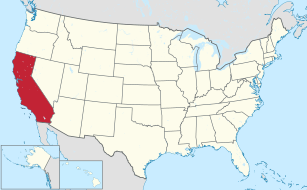The Mission Inn Hotel & Spa
|
Mission Inn | |
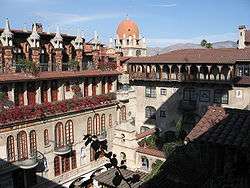 Mission Inn, Riverside, California | |
  | |
| Location | 3649 Mission Inn Ave, Riverside, California |
|---|---|
| Coordinates | 33°59′00″N 117°22′22″W / 33.98333°N 117.37278°WCoordinates: 33°59′00″N 117°22′22″W / 33.98333°N 117.37278°W |
| Built | 1902–1932[1] |
| Architect | Multiple |
| Architectural style | Mission/Spanish Revival |
| Restored | 1985–1992 |
| Restored by | Carley Capital Group and Duane Roberts |
| NRHP reference # | 71000173[2] |
| CHISL # | 761 |
| RIVL # | 1 |
| Significant dates | |
| Added to NRHP | May 14, 1971 |
| Designated NHL | May 5, 1977 |
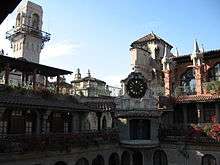
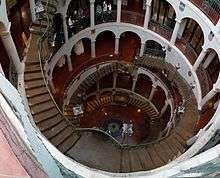
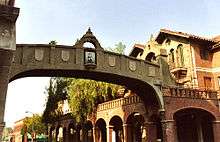
The Mission Inn, now known as The Mission Inn Hotel & Spa, is a historic landmark hotel in downtown Riverside, California. Although a composite of many architectural styles, it is generally considered the largest Mission Revival Style building in the United States. Mission Inn Hotel & Spa is a member of Historic Hotels of America, the official program of the National Trust for Historic Preservation.[3]
The owners are Duane and Kelly Roberts. Kelly serves as Vice Chairman and Chief Operating Officer (COO) of the Mission Inn, overseeing its daily operations.
History
The property began as a quaint adobe boarding house called "The Glenwood Cottage", built by engineer/surveyor Christopher Columbus Miller and on November 22, 1876, the Millers took their first paying guest. In February 1880, Miller's son Frank Augustus Miller purchased the hotel and land from his father. It blossomed into a full-service hotel in the early 1900s due to California's economic citrus boom and warm weather, attracting wealthy travelers and investors from East Coast and Europe.[4] In 1902, Frank changed the name to the "Glenwood Mission Inn" and started building, in a variety of styles, until he died in 1935.
Miller's vision for the eclectic structure was drawn from many historical design periods, revivals, influences, and styles. Some are Spanish Gothic architecture, Mission Revival Style architecture, Moorish Revival architecture, Spanish Colonial style architecture, Spanish Colonial Revival Style architecture, Renaissance Revival architecture, and Mediterranean Revival Style architecture. With one section over another, addition upon addition, the result is a complicated and intricately built structure. It contains narrow passageways, exterior arcades, a medieval-style clock, a five-story rotunda, numerous patios and windows, castle towers, minarets, a Cloister Wing (with catacombs), flying buttresses, Mediterranean domes and a pedestrian sky bridge among many other features.
During the 30-year construction period, Miller traveled the world, collecting treasures to bring back to the hotel for display.
The St. Francis Chapel houses four large, stained-glass windows and two original mosaics by Louis Comfort Tiffany in 1906. The windows were salvaged from the Madison Square Presbyterian Church and the chapel purpose built to house them. The Mexican-Baroque styled "Rayas Altar" is 25 feet tall by 16 feet across, carved from cedar and completely covered in gold leaf. For his "Garden of Bells," Miller collected over 800 bells, including one dating from the year 1247 described as the "oldest bell in Christendom."
In 1932, Frank Miller opened the St. Francis Atrio. The "Famous Fliers' Wall", added by Miller’s son-in-law DeWitt Hutchings, was used to recognize notable aviators, including Amelia Earhart. On March 20, 1942, World War I ace Eddie Rickenbacker was honored at the Inn, becoming the fifty-seventh flier added to the monument. Today, 151 fliers or groups of fliers are honored by having their signatures etched onto 10-inch-wide (250 mm) copper wings attached to the wall.
Frank Miller died in 1935 and the Inn continued under the management of his daughter and son-in-law, Allis and DeWitt Hutchings, who died in 1956.[5] The Inn then went through a series of ownership changes and some of its older rooms were converted to apartments and used as dorms for UC Riverside. In the early 1960s, St. John's College considered buying it as a location for its western campus but abandoned negotiations when John Gaw Meem donated land in Santa Fe.
The hotel was later acquired by the Carley Capital Group and was closed for renovations in 1985 at a cost of $55 million. Newly discovered structural problems cost more than expected and caused the company to fall behind on loan payments to a New York bank. This caused work on the nearly completed hotel to be halted, just weeks before its planned opening in December 1988 as the Omni Mission Inn. In December 1992, the Inn was sold to Duane Roberts, a Riverside businessman. Roberts completed the renovations and it was reopened to the public shortly thereafter.
Architecture
With its widely varying styles, the Mission Inn was designed by multiple architects.[6] Frank Miller selected Arthur B. Benton to design the original building. Miller chose Myron Hunt to design the Spanish Wing added to the rear of the main building. He later hired G. Stanley Wilson to design the St. Francis Chapel. Wilson also added a rotunda featuring circular staircases and a dome.
Notable guests
For 140 years, the Mission Inn has been the center of Riverside, host to U.S. Presidents, celebrities, a number of seasonal and holiday functions, as well as occasional political functions and other major social gatherings.[7] Pat and Richard Nixon were married in what is now the Presidential Lounge, Nancy and Ronald Reagan honeymooned there, and eight other U.S. Presidents have visited the Inn: Benjamin Harrison, William McKinley, Theodore Roosevelt, William Howard Taft, Herbert Hoover, John Fitzgerald Kennedy, Gerald Ford, and George W. Bush.
Social leaders who have stopped at the Mission Inn include Susan B. Anthony, Henry Ford, Andrew Carnegie, John D. Rockefeller, Henry Huntington, Albert Einstein, Joseph Pulitzer, William Randolph Hearst, Hubert H. Bancroft, Harry Chandler, Booker T. Washington, Helen Keller and John Muir.
The list of entertainers who have toured the Inn is extensive. Lillian Russell, Sarah Bernhardt and Harry Houdini were early visitors to Frank Miller’s hotel. Other guests have included actors such as Ethel Barrymore, Charles Boyer, Eddie Cantor, Mary Pickford, Ginger Rogers, Bette Davis (who was married at the Inn in 1945), W. C. Fields, Clark Gable, Cary Grant, Spencer Tracy, Fess Parker, James Brolin and Barbra Streisand, Raquel Welch and Drew Barrymore. Other celebrities such as Jack Benny, Bob Hope, Glen Campbell, Merle Haggard and Tears for Fears have stopped by.
The Inn continues to be a getaway for notable individuals to this day. Arnold Schwarzenegger has stayed there during his tenure as Governor of California and the Osbournes have also paid a visit in the past few years.
Popular culture
In 1909 Carrie Jacobs-Bond wrote the lyrics for her famous song "A Perfect Day" while staying in the Mission Inn.[8] For many years the Mission Inn's carillon played "A Perfect Day" as the last tune each evening.[9] In 2016, the Mission Inn announced the return of daily performances of "A Perfect Day" as part of its commitment to preserve the history of the hotel.
American author Anne Rice so enjoyed the Inn she incorporated it into her 2009 book Angel Time. The book is the first in Rice's Songs of the Seraphim series, which tells the story of Toby O'Dare, an assassin with a tragic past, who uses the Mission Inn as his refuge.
The Inn's unique architecture and ambiance have attracted many film makers. Film shoots at the Inn include 1938's Idiot's Delight with Clark Gable, 1969's Tell Them Willie Boy Is Here with Robert Redford, 1975's The Wild Party with Raquel Welch and James Coco, Billy Wilder's 1981 comedy Buddy Buddy with Jack Lemmon and Walter Matthau, 1988's Vibes with Jeff Goldblum, 1977's Black Samurai with Jim Kelly, and 1998's The Man in the Iron Mask with Leonardo DiCaprio.
Eddie Money filmed the music video of "Think I'm In Love" at the Inn.
The Sliders season 3 episodes 16 and 17 ("Exodus", parts I and II) were shot extensively in the Mission Inn, which played as a military base.
Today
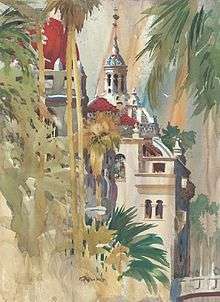
The hotel, which occupies an entire city block, has 4 restaurants, a day spa and 239 guest rooms (nine rooms designated as presidential suites). It is a National Historic Landmark, a California Historical Landmark, and Riverside City Landmark #1.[10] The hotel's aesthetic charm makes it a frequent subject for local artists.
Dining
The hotel features four restaurants and two lounges.
Mission Inn Museum
The Mission Inn Museum promotes the cultural heritage of the Mission Inn. Permanent exhibits feature the history of the inn and its founders, and the museum offers changing exhibits and educational programs.
See also
- Mount Rubidoux – a city park in Riverside developed from land donated by the Miller family.
References
Bibliography
- Gale, Zona. Frank Miller of the Mission Inn. D. Appleton-Century Co., New York. 1938. OCLC 2181944
- Hall, Joan H. Through the Doors of the Mission Inn. Highgrove Press, Riverside, California. 1996. ISBN 0-9631618-2-2. OCLC 34655850
- Hall, Joan H. Through the Doors of the Mission Inn; Volume Two. Highgrove Press, Riverside, California. 2000. ISBN 0-9631618-3-0. OCLC 45279767
- Hodgen, Maurice. Master of the Mission Inn: Frank Miller, a Life. North Charleston, SC, Ashburton Publishing, c2013. ISBN 9780976278511 OCLC 876931972
- Hutchings, DeWitt . Handbook of the Mission Inn, Riverside, California. Frank A. Miller. 1951. OCLC 14473934, 20347083
- Klotz, Esther. The Mission Inn: Its History and Artifiacts. Rubidoux Printing, Riverside, California. 1981. OCLC 9255879
- Moore, Barbara (editor). Historic Mission Inn. Friends of the Mission Inn, Riverside, California. 1998. ISBN 0-9666914-0-7. OCLC 40414169
- Parks, Walter P. The Famous Fliers' Wall of the Mission Inn. Infinity Press, Orange, California. 2004. Library of Congress Number 86-90693. OCLC 15998708
- Mission Inn. The Bells and Crosses of the Mission Inn, Riverside, California. (between 1927 and 1938).
OCLC 40809070
- An earlier version is available as Bells and crosses of the Mission Inn and the Ford Paintings of the California Missions [1908?]. OCLC 276859296 (available as a digitized version, and which includes a reference to the paintings of the California Missions done by Henry Chapman Ford)
Citations and notes
- ↑ Riverside Cultural Heritage Board (January 2002). "Landmarks of the City of Riverside" (PDF). City of Riverside. Retrieved 2013-02-28.
- ↑ National Park Service (2007-01-23). "National Register Information System". National Register of Historic Places. National Park Service.
- ↑ "Mission Inn Hotel & Spa, a Historic Hotels of America member". Historic Hotels of America. Retrieved January 28, 2014.
- ↑ Lech, Steve (2007). Riverside 1870–1940. Charleston, SC: Arcadia Publishing. ISBN 978-0-7385-4716-9. OCLC 127273299.
- ↑ Hall, Joan H., Through the Doors of the Mission Inn Vol. 1. Copyright Highgrove Press, Riverside, 1996.
- ↑ Holliday, Peter J. (2016). American Arcadia: California and the Classical Tradition. Oxford University Press. ISBN 9780190256517.
- ↑ Hall, Volume I and II.
- ↑ The place of composition is indicated in a line inserted above the title on p. 3 of the high voice (soprano) edition published in 1938 by the Boston Music Company; this version is in the key of C. Jacobs-Bond added the tune for "A Perfect Day" during a visit to the Mojave Desert 3 months after her visit to the Mission Inn (Rick Reublein on "America's first great woman popular song composer" site).
- ↑ Mission Inn Museum site for Carrie Jacobs-Bond. Archived 2009-07-06 at the Wayback Machine.
- ↑ City of Riverside Historic Districts and Buildings Archived 2011-07-21 at the Wayback Machine.
External links
| Wikimedia Commons has media related to Mission Inn. |

